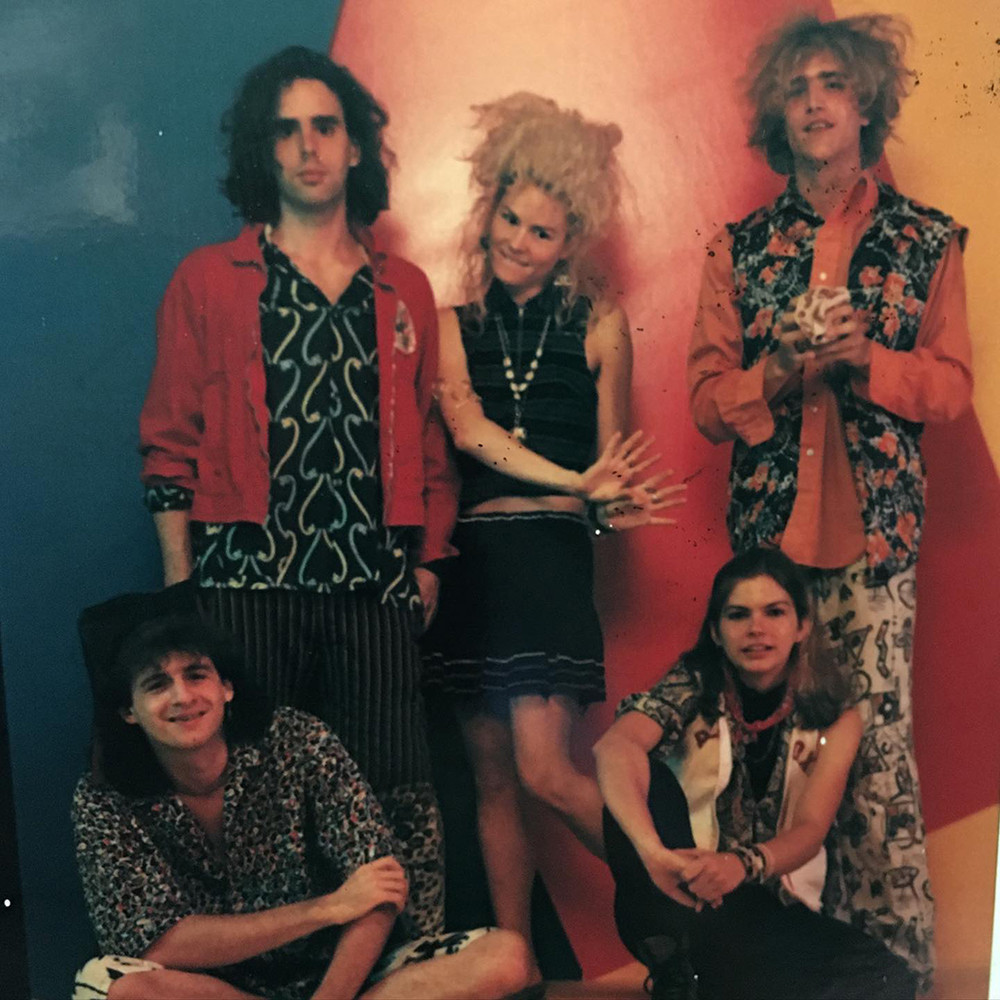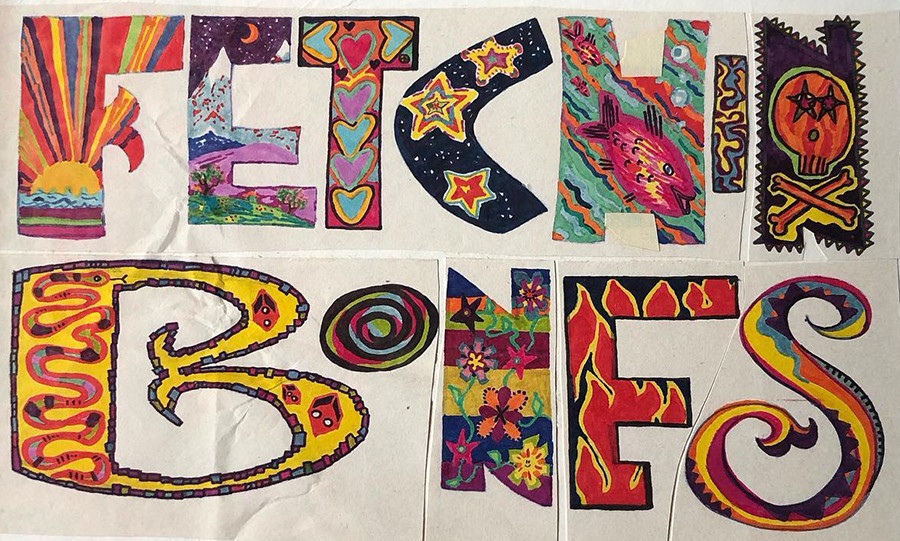Fetchin Bones, a band that might have been a fleeting encounter for some, carved a significant chapter in the musical journey of many, particularly during their vibrant run from 1985 to 1990. Like a cherished relationship that evolved over time, their music resurfaced in 2007 with the raw, live energy of Dead Band Rockin’, a release that reignited the passion and reaffirmed their status as masters of Live Band Songs. Since then, their tracks have become a dynamic soundtrack to life’s varied moments, proving that the right song at the right time can resonate deeply.
 Fetchin Bones circa 1987
Fetchin Bones circa 1987
Perhaps this connection felt personal; after all, music often speaks directly to the soul. The news of Fetchin Bones reforming for their induction into the North Carolina Music Hall of Fame was a signal to crank up the volume once more, revisiting the sounds that echo with youthful energy and raw performance. A conversation with Hope Nicholls, the band’s singer and percussionist, revealed that the surprise was mutual.
“We found out about the possibility of the North Carolina Music Hall of Fame early in 2023. Since it was to be the entity Fetchin Bones inducted, I insisted it be all seven recording members, as there are two albums with each incarnation and all four albums do stand the test of time to me,” Nicholls shared. This reunion was not just a nod to nostalgia but a recognition of the band’s full artistic scope. “Although the Galaxy 500 / Monster line-up is the definitive line-up, we are grown-ups now. Wiser, and great friends. We honor and respect Gary White and Marc Mueller and all the amazing things we did in support of the first two albums. All the amazing work they did artistically.”
With four studio albums, two distinct lineups, and the electrifying Dead Band Rockin’ live album, Fetchin Bones’ discography remains remarkably relevant. For new listeners, their music slots seamlessly alongside today’s alternative and indie favorites, offering a timelessly cool and intensely vibrant sonic experience. Diving into their catalog, whether through albums, tracks, or digital streams, is an invitation to head-nodding rhythms and foot-tapping beats. Listeners might detect hints of grunge, a spark of riot grrrl energy with a Southern twist, and a dash of jangle-pop reminiscent of R.E.M. infused with a paisley underground vibe. Yet, there’s also a thread of groovy, alternative funk interwoven with more introspective pieces. Everything blends naturally, especially their captivating live sound, often likened to a fusion of early Jane’s Addiction and Gun Club. Remarkably, Fetchin Bones pioneered this sound landscape well before many of these influences became mainstream.
Their debut LP, Cabin Flounder, dropped in 1985, predating Jane’s Addiction’s Nothing’s Shocking and L7’s first album by three years, and Hole’s Pretty on the Inside by six years. Sandwiched between were Bad Pumpkin (1986) and Galaxy 500 (1987), forming a quartet of chaotic, melodic, grunge-rock-twang-punk-metal-pop albums that resonated on indie radio long before Nirvana’s Nevermind introduced alternative to the masses in 1991. Contemporaneously, R.E.M. was releasing Murmur and Reckoning, Pylon delivered Chomp, and The Replacements urged us to Let it Be. Fetchin Bones aligned more closely with this era’s sonic sensibilities. Nicholls recounts that in their early days in Charlotte, NC, local recognition was scarce until their first record gained traction. Athens, GA, however, was immediately receptive.
“We were pals with the guy who owned Charlotte’s iconic punk rock club, The Milestone. He would book us, even when it was just Aaron Pitkin and I and a Dr. Rhythm machine, as an opening act. One night we opened for Art in the Dark from Athens. They liked us a bunch and said people in Athens would get what we were doing, so we went down there to open for them, and it was an instant smash. It was crazy! Very quickly we were on big shows there and going to play 688 in Atlanta. It was that GA buzz that caught Danny Beard’s attention. To be on DB RECS is/was a huge honor, as the B-52’s and Pylon are two acts that were hugely influential on me. Once Cabin Flounder came out, the Charlotte Observer picked up on us, but we never were as big in Charlotte as we were in Atlanta, probably because Charlotte has never been a music city like those in GA.”
Fetchin Bones’ music, inspired by diverse sounds and embraced by dedicated fans, occupied a unique niche in the left-of-the-dial era. Their “alternativity” might be why they remain somewhat under the radar. It wasn’t a lack of quality or vision, but rather their inherent nature as an alternative to the mainstream. While other bands climbed charts and gained global fame under the ‘alternative’ banner, Fetchin Bones, perhaps unintentionally, embodied the true essence of the word. They defied easy categorization, blending elements of grunge, jangle, pop, country, Americana, metal, funk, and punk. This distinctive blend remains potent, and reuniting all band members after years apart must have been emotionally charged.
Nicholls describes the reunion dynamics: “The first two Fetchin Bones albums are with Gary and Marc. When they quit, we were not in touch with Marc basically until about a year ago. Social media finally got us reunited! Except for a couple years of bitterness right after they left, Gary has been a constant friend. We have visited each other with our kids and stayed very close through the decades. Clay Richardson is here in Charlotte, so we always saw him frequently through the years. Danna Pentes and Errol Stewart have family here, so we also saw them intermittently over the years too. In 2000, we did a pilot reality TV show for VH1 with Errol and Clay in LA and Charlotte. Then we did Dead Band Rockin’ shows with them in 2007. But all seven rehearsing at my house this October and doing the set at NCMHOF was unprecedented. It felt like we were finally all grown up! There did not seem to be any residual resentment or drama. It was a beautiful thing.”
The interconnectedness of the band members mirrors the way their music resonates deeply. For many, Fetchin Bones isn’t just a band; it’s a musical touchstone, intrinsically linked to personal histories and shared experiences. They occupy a special place alongside bands like The Donner Party, The Cat Heads, The Dream Syndicate, Tex & The Horseheads, The Flesheaters, Divine Horsemen, and Sister Double Happiness. While some of these bands lean towards a California sound and Fetchin Bones hails from North Carolina, they share a similar spirit and occupy the same mental and emotional space for devoted listeners, evoking powerful memories.
And considering the jangle element, Don Dixon produced their first three albums, known for his work with Dumptruck, the Smithereens, R.E.M., and a key figure in shaping the jangle-pop genre. While jangle is present, it’s interwoven with raw rock energy and diverse influences. Fetchin Bones effortlessly transitions from sounding like the ultimate bar band to a melodic pop act to hard-edged alternative rockers, all within the same set – a testament to their versatility as a live band.
The affection for Fetchin Bones is profound and enduring. Multiple vinyl and cassette copies of their albums, worn from countless plays, are a testament to their impact. “Deep Blue,” a standout track, has graced numerous mixtapes. Their electrifying live performance in the film A Matter of Degrees (1990) is a highlight of the movie. Even a cherished vintage t-shirt, long disintegrated, was recently replaced, and a new one acquired to mark their Hall of Fame induction.
 Fetchin Bones multi-colored logo t-shirt
Fetchin Bones multi-colored logo t-shirt
Despite the long gap since their last studio album, their music remains timeless. Listening now evokes a sense of nostalgia blended with a contemporary feel. Their songs straddle the line between capturing a specific era and sounding perpetually fresh and dynamic – a quality rooted in their organic, unforced musical approach. This authenticity, however, also contributed to Monster being their final studio album for a time.
Nicholls explains their creative ethos: “We want other people’s ideas. Working as an art gang to figure out how to take a few notes, a vocal idea or a beat, and hammer those into a song, that’s so fun! This process is why we broke up Fetchin Bones. It had gotten to a point where it was not that fun. There are lots of ways to make money that suck. Making art shouldn’t one of them. It should be fun and if it makes money and people like it, that’s like an extra bonus!”
Post-Fetchin Bones, Nicholls formed Sugarsmack in the 90s and Snagglepuss in the 2000s. While Snagglepuss released four albums, they didn’t achieve the same reach as Fetchin Bones. “If you missed Snagglepuss, it was because we stuck around here as we had very small kids, but we did do four albums with Don Dixon.” Meanwhile, Marc Mueller, under the moniker The Street Mule, became a fixture in the NYC subway, selling albums and performing extensively.
Music has remained a constant, even as band names and lineups evolved. A discernible sonic thread connects these projects, yet each band possesses its unique identity. “We have never been a super nostalgic bunch, so to me, unless a band is writing new material, what’s the point,” Nicholls remarks. The challenges of long-distance songwriting and a preference for creating new art over solely revisiting the past also played a role.
The explosive 2007 live album Dead Band Rockin’ was a singular event. Further reunions seemed improbable at the time. “There was no talk of further shows after Dead Band Rockin’, as Errol and Aaron and I all had young kids at the time,” Nicholls recalls. Geographic distance further complicated matters.
Currently, Nicholls is active with It’s Snakes, a band featuring herself on drums and vocals alongside Aaron Pitkin, Darrin Gray, and Greg Walsh. While echoes of Fetchin Bones resonate in It’s Snakes’ music, they forge their distinct path. “After Monster and Fetchin Bones,” Nicholls reflects, “Aaron and I always felt we were just making more art. It was fun to start again with just him on Sugarsmack. But we love collaborating with others, so we always ask friends to join us in the process. Aaron wanted to have a fresh start, so with each band he switched up on what he was playing: bass for Sugarsmack, drums for Snagglepuss. Then I felt like it would be good for me to do that, so for It’s Snakes, I decided to play drums and sing, while he went back to his first love, guitar. There is a similarity with Fetchin Bones and It’s Snakes, in that guitar riffs and melodies are the starting point for most songs. He wrote many Fetchin Bones songs on acoustic guitar and same with It’s Snakes. I think what does give all four bands a definite individuality is the players we work/worked with.”
As 2023 concludes, the music continues, evolving under different names and formations. Yet, Fetchin Bones endures – a testament to the lasting impact of a band that truly understood the electrifying power of live band songs.
Fetchin Bones Lost Demos
Fetchin Bones Instagram
See Also: IT’S SNAKES
